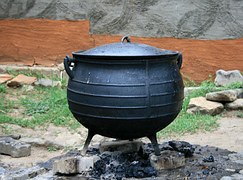Cast Iron Information

There are three popular types of Cast Iron. White Cast Iron has carbide impurities which allow cracks to pass straight through; Gray Cast Iron has graphite flakes which deflect a passing crack and initiate many more new cracks. Ductile Cast Iron which stops the crack from further progressing due to their spherical graphite nodules.
Gray Cast Iron is the most commonly used cast iron and the most widely used cast material. Gray Cast Irons have a composition of 2.5-4% Carbon, 1-3% Silicon and the rest is Iron. Gray Cast Irons properties are controlled by the size and shape of the graphite flakes. Gray Cast Iron cannot be forged, extruded, rolled etc. even at when heated. Uses of Gray Cast Iron include automotive engine blocks, gears, flywheels, brake discs and drums, and machine bases. Gray iron serves well in machinery applications because of its good fatigue resistance. Gray Cast Iron looks gray when fractured.
White Cast Iron looks white when fractured. White cast iron is hard but brittle and a low melting point. The Carbon in the White Cast Iron precipitates and forms larger particles that increase the hardness of the Cast Iron. It is abrasive resistanence and cost making it useful in various applications like lifter bars and shell liners in grinding mills, wear surfaces of pumps amoung other specialty items.
Ductile Cast Iron is a third type of Iron alloy (Carbon 3.2 to 3.60%, Silicon 2.2 to 2.8%, Manganese 0.1 to 0.2%, Magnesium 0.03 to 0.04% with the rest being Iron. Much of the annual production of ductile iron is in the form of ductile iron pipe, used for water and sewer lines but also in some automotive parts where steel isn't required but Aluminum isn't strong enough.
Cast Iron has a melting temperature of 1,150-1,200C (2,100-2,190F).
